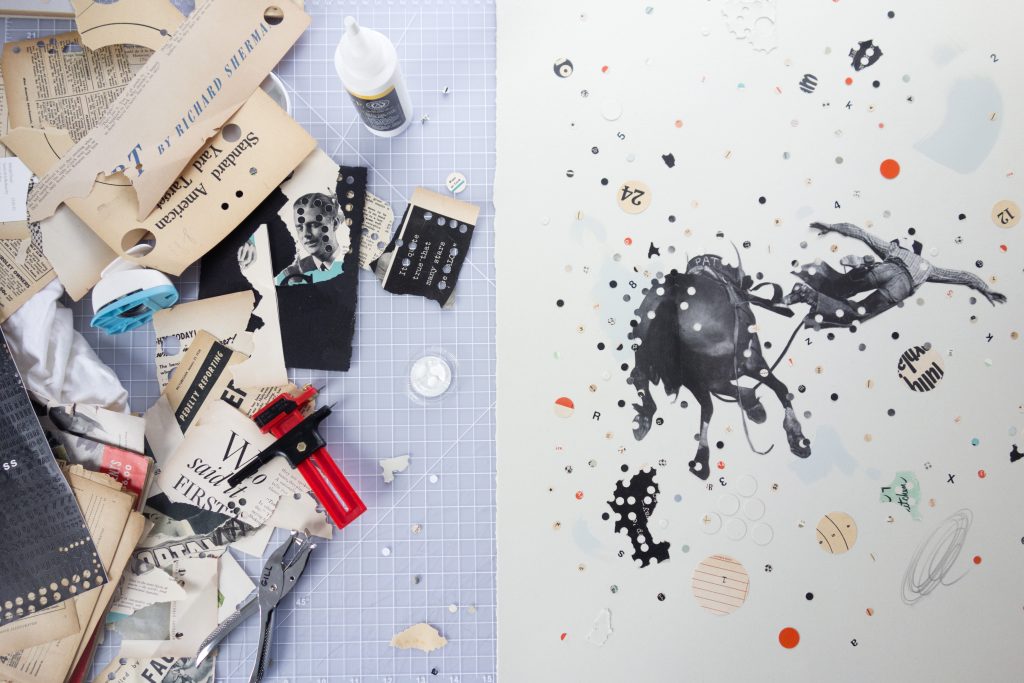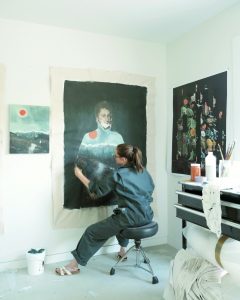Interview: Retro-Americana Artist Lizzie Gill Twists Time
Traveling from her revitalized barn in Connecticut to a collage workshop at Soho House’s White City Studio in London

Chances are you’ve seen artist Lizzie Gill‘s time-twisting collage work, whether or not you’ve been to her most recent gallery show in the Hamptons. As Gill has developed her fine-art practice, she’s also become an award-winning photo illustrator for The New York Times. Her editorial illustrations—much like her large-scale, mixed-media paintings—tell tales themselves. They do so as textured, allegorical landscapes; through an explosive anachronistic energy that places ideas into opposition. This summer, we ventured to Gill’s barn-turned-studio in Sharon, Connecticut and later joined her for a collage workshop at Soho House’s White City Studio outpost in London. Through both experiences, we learned of Gill’s vision and the mission behind her craft.

“I do my mixed-media paintings here,” Gill tells us as we walk through the ground floor of her art studio. Gill and her husband, art advisor and Wave Projects founder Tom Pillar, live in the open-plan space above the studio, all within the ’90s barn that they renovated earlier in the year. On their lush property sits an enchanting, distressed 1860s farmhouse that will need even more repair to be habitable.
“We do a lot of the image transfer process here—I say ‘we’ because my husband helps out quite a bit—where I research to find images that I am interested in using, from either the 1950s or the 1550s, as of recently,” she explains. “Then, I transfer them to then canvas and use oil paint and acrylic to make these new vistas. I work sometimes on the floor, stretching out the canvas and priming it; I work sometimes on the walls.” The poured-concrete flooring allows Gill to spill and make a mess—though during our visit everything was meticulous.
“I think maybe there’s a relationship in the way that I organize my materials and the process behind my collage,” she says. “The collages are supposed to look like a random burst of energy but all the dots are placed in specific spots that look random.” It’s her version of organized chaos.

Gill’s studio is oriented toward rolling, tree-covered hills—a scene unlike her life in Brooklyn not that long ago. “I paint and stare out at the landscape every day,” she says. The space “was a two-stall horse stable with a dirt floor. We redesigned it with our contractor. We really wanted the room to have an inside-outside feel.” This resulted in three large floor-to-ceiling windows beside a door to a patio and picnic table. Light plays an important role within.

As for Gill’s work, there’s an inherent cinematic quality. She admits to being drawn to the domestic theatricality of 1950s imagery. “People were assigned their roles and they had to perform in them,” she says, adding that it’s much the same with 17th century portraits she’s recently begun to work with, as well. It’s the collision of it all that spawns meaning. Gill’s works upend memory, address how empires are built and destroyed (by pairing pedals and bombers) and warp contemporary culture.
“I love having multiple layers of different mediums, and making them all work together,” she says of the tactile process. “It’s like being a bit of a chemist. Each layer has to react with the one beneath it.”

Ideologically-charged works populated Gill’s Roman Fine Art exhibition Midnight Sun at The Townhouse Sag Harbor earlier this year. “It’s an exploration of new work by me,” she says of the show. “I juxtapose landscape and 17th century Dutch portraiture, creating new vistas and using the landscape as a self-portrait. It’s done in a way where there is no rationality anywhere. But the ‘midnight sun’ is used in several ways to bring back the idea of logic. It is representative of a gravitational pull.” There’s an element of surrealism to each.

Gill approaches each with a foundation vision. “I definitely have things in mind when I start a new work,” she says, “because there is a printed process that requires planning. I have to find the images that I am appropriating, scale them up or down, cut them up digitally and create the pieces that I will make the large-scale collage out of. There’s always an element of planning but I try to put an end to planning at a certain point—so that once that is all on the canvas and I begin to paint, the painting process takes over. I can react to the image.”
The initial image transfer is never perfect. “It’s actually kind of like an archaeological process, where you paste it down and rub away the paper pulp. You reveal a new surface. It’s about making something new out of these pulled marks.”

Across the Atlantic, we witnessed part of this process in London’s White City Studio. Equipped with 400 issues of Country Life magazine, scissors and glue for all to use, Gill guided guests through their own cathartic collage endeavor. Gill took time to sit with each individual and talk to them about color, texture, tone and theme. Quips—from “turn that entire thing upside down” to “save those pieces for something else”—transformed people’s attempts. Gill made the process fun and easy.
Now back in the US, Gill will oversee a collage workshop for adults at The Lantern in Wassaic, New York on Saturday, 28 August. The ticketed event includes beverages and bites as well as a complete collage kit, and all participants will depart with a work of their own imagining. While it may be unlikely that someone produces something as masterful as Gill’s own time-twisting collages, to have her on hand is reason enough to sign up.
Hero image courtesy of Lizzie Gill












